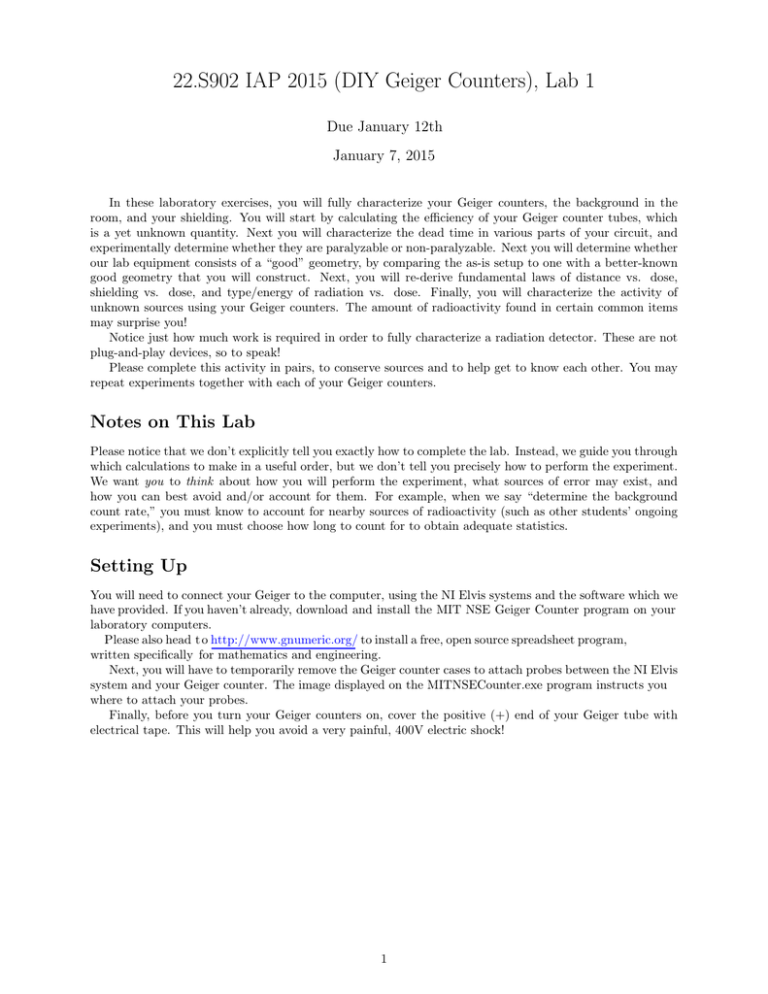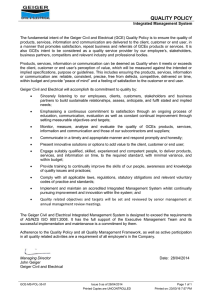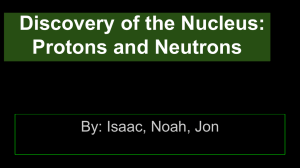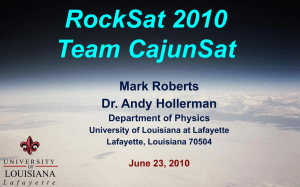22.S902 IAP 2015 (DIY Geiger Counters), Lab 1 Due January 12th
advertisement

22.S902 IAP 2015 (DIY Geiger Counters), Lab 1 Due January 12th January 7, 2015 In these laboratory exercises, you will fully characterize your Geiger counters, the background in the room, and your shielding. You will start by calculating the efficiency of your Geiger counter tubes, which is a yet unknown quantity. Next you will characterize the dead time in various parts of your circuit, and experimentally determine whether they are paralyzable or non-paralyzable. Next you will determine whether our lab equipment consists of a “good” geometry, by comparing the as-is setup to one with a better-known good geometry that you will construct. Next, you will re-derive fundamental laws of distance vs. dose, shielding vs. dose, and type/energy of radiation vs. dose. Finally, you will characterize the activity of unknown sources using your Geiger counters. The amount of radioactivity found in certain common items may surprise you! Notice just how much work is required in order to fully characterize a radiation detector. These are not plug-and-play devices, so to speak! Please complete this activity in pairs, to conserve sources and to help get to know each other. You may repeat experiments together with each of your Geiger counters. Notes on This Lab Please notice that we don’t explicitly tell you exactly how to complete the lab. Instead, we guide you through which calculations to make in a useful order, but we don’t tell you precisely how to perform the experiment. We want you to think about how you will perform the experiment, what sources of error may exist, and how you can best avoid and/or account for them. For example, when we say “determine the background count rate,” you must know to account for nearby sources of radioactivity (such as other students’ ongoing experiments), and you must choose how long to count for to obtain adequate statistics. Setting Up You will need to connect your Geiger to the computer, using the NI Elvis systems and the software which we have provided. If you haven’t already, download and install the MIT NSE Geiger Counter program on your laboratory computers. Please also head t o http://www.gnumeric.org/ to install a free, open source spreadsheet program, written specifically for mathematics and engineering. Next, you will have to temporarily remove the Geiger counter cases to attach probes between the NI Elvis system and your Geiger counter. The image displayed on the MITNSECounter.exe program instructs you where to attach your probes. Finally, before you turn your Geiger counters on, cover the positive (+) end of your Geiger tube with electrical tape. This will help you avoid a very painful, 400V electric shock! 1 Key Calculations Fill in these values as you calculate or discover them. It will be helpful to have them all in one place. Number Room Background Count Rate Source Used for Initial Experiments True 60 Co Source Activity from Mar. 2011 Expected Count Rate at 100% Efficiency Tube Solid Angle 1” from Source True Geiger Tube Efficiency at 400V True Geiger Tube Efficiency at 350V True Geiger Tube Efficiency at 450V Geiger Tube Dead Time Pulse Stretcher Dead Time Buildup Factor of Your Chosen “Bad” Setup Expected Activity of Bag of KCl Road Salt Measured Activity of Bag of KCl Road Salt Expected Activity of Two Humans Calculated Activity of Two Humans 1 Value (Units) Uncertainty (10 points) Background Counts Using your Geiger counter, Determine the background count rate in the laboratory. You will have to choose a suitable counting time, based on the number and statistical quality of the counts that you get. Make multiple measurements after counting for 1, 3, and 5 minutes. Repeat the 1 minute count rate three times: Background counts/min at 1 minute: Background counts/min at 3 minutes: Background counts/min at 5 minutes: What sources of error exist in your measurements? Now quickly look at the reading for Day 4 (I’m assuming you’ve started this lab on Day 3). Start on p. 321. Based on your count rate, how long would you have to count to be 95% confident in your background count rate? Sources of Error: Time to 95% confident background count rate: If required, perform your background count rate calibration at this time. Use this value in the remaining experiments. 2 2 (10 Points) Source Characterization For this experiment, you will want to use the two 60 Co sources. One has a very precise date stamp, while the other does not. From Problem Set 1, write down the activities and uncertainties of the two 60 Co sources: Old 60 Co source: New 60 Co source: ± ± Now obtain count rates for both sources, by counting for a suitable amount of time using each source (one at a time) at a distance of 3”. This is done to reduce the percent dead time in our Geiger counter, by keeping the count rate relatively low. Based on the stated activities, the calculated old source activity, and the measured count rates for both sources, what is the true activity of the new 60 Co source? Based on this number, what is the expected day of calibration of the newer source? New New New 60 ± ± ± Co source count rate: Co source activity: 60 Co source day of calibration: 60 Do not forget to subtract your background count rate from these figures! 3 3 (10 points) Geiger Tube Characterization Now we will figure out what percentage of the gamma rays that interact with the gases in our Geiger tubes actually get counted. First, assuming that you place a source of true activity A ± ∆A of your choice at a distance of 1” away from the Geiger tube, calculate the expected count rate in your Geiger tube. You will need to determine the solid angle of your tube relative to the source, as well as any shielding from materials between the Geiger tube and the source. Next, place the source of your choice 1” away from your Geiger tube, and measure the count rate for a suitable amount of time. Record the net count rate from the source. Finally, determine the ratio between these expected and measured count rates. This is your tube efficiency, for this source! Tube efficiencies will vary for different types and energies of radiation. Expected count rate: Measured count rate: Tube efficiency: ± ± ± Repeat this exercise, but this time use the plastic screwdriver to vary your Geiger tube voltage between 350-450V, in increments of 25V. Graph your tube efficiency for your source as a function of voltage: Repeat this exercise only at 400V, except use a different source. How can you explain the differences in tube efficiencies? 4 4 (10 points) Characterizing Dead Time Place a source as close as you can to your Geiger tube. If you haven’t yet, you may want to place black electrical tape over the blue speaker now. Acquire counting statistics for 2 minutes. Now repeat this exercise, except change your positive (red) probe to a location on the output of the pulse stretcher. Based on the distributions of count arrival times that you measure, what is the dead time in the Geiger tube? What about the pulse stretcher? How do you know? Now look closely at the shapes of the distributions of count rates for very short times (near the dead time). What do the shapes of the distributions tell you about the paralyzability of the Geiger tube? What about the pulse stretcher? 5 (20 points) MacGyvering a “Good” Geometry In all your previous experiments, we were assuming that we had a “good” geometry. In other words, we assumed that any beta/gamma ray that underwent an interaction of any kind (absorption, scattering...) left the beam. This is not actually the case. Explain, using sketches if it helps, why our current geometry is not “good.” Think about possible ways by which beta/gamma rays from our sources may enter the Geiger tube. Based on your explanation above, and using anything that you can find in/near the laboratory room, construct and test a “good” geometry setup. Make sure not to actually shield the source, rather try to ensure that fewer scattered beta/gamma rays will enter your detector. Sketch or take a picture of it below: Now, using a source of your choice, measure the count rates using your “good” and “bad (original) geometries. By what factor do they differ? This is what is known as a buildup factor. What is causing the buildup factor to be greater than one in our bad geometry? What esle could you do (given infinite resources) to ensure a “good” geometry, better than the one you constructed? 5 6 (10 points) Experimentally Deriving Distance Laws Now we will see if the supposed r12 distance vs. dose scaling law holds true in the laboratory. Using a source of your choice, and using our original “bad” geometry, measure count rates at the seven distances marked on your fiberboard jig. These holes were cut to help reduce uncertainty in distance measurements. Graph the relationship between distance from the source and measured count rate: How close is your measured relationship to the expected “good” geometry. How much closer did you get? 6 1 r2 ? Now repeat your measurements for your 7 (10 points) Experimentally Deriving Percent Dead Time We have already characterized the dead time τ in our Geiger counters. Now we will figure out what our percent dead time is at different count rates. Look carefully at the count interval distributions for the experiments in Problem 6. The dead time of the Geiger counter should be quite evident. How will you estimate the percent dead time in your measurements, and your graph above? Produce a graph of count rate vs. percent dead time from your results: 7 8 (20 points) Measuring Linear Attenuation Coefficients In front of you are 4-5 pieces of 0.075” thick commercially pure titanium. Don’t look up the value of its linear attenuation coefficient just yet. Choose a distance on your experimental jig with a suitably low (<5%) percent dead time from Problem 7. Using our original “bad” geometry, place the source of your choice at this location, and measure count rates with between 0-4 pieces of Ti shielding between your source and your detector. Place the Ti shielding very close to the source. You will have to choose how long to count in each case. Plot the count rate vs. shielding thickness below: Now repeat the experiment, except put the Ti shielding as close as possible to the Geiger tube. Plot these values on your graph above. Finally, repeat this experiment using a “good” geometry. Plot these values on your graph above. What are your buildup factors with the Ti shielding close to the source, and close to the detector, compared with the “good” geometry? Write down the experimentally determined linear attenuation coefficient for Ti and your source’s beta/gamma energy, compared to the measured value: Percent dead time µT i with Ti near source: µT i with Ti near detector: µT i with “good” geometry: µT i , true value: 9 ± ± ± (20 points extra) Determining Unknown Source Activities Road deicing salt, commonly made of KCl, has a certain fraction of naturally occurring 40 K. Calculate the expected activity of the bag of KCl road salt. Now measure it using your Geiger counter, while doing whatever you need to ensure low dead time, good geometry, accurate background subtraction, and anything else you need to quantify uncertainty. Note here that the bag of KCl is not a point source! Also note that humans contain potassium, some of which is 40 K. Calculate the expected activity of two humans (yes, your dose does increase next to other people!). Now try to measure it. Based on your expected (calculated) activity, should you be able to measure the activity of two humans using our Geiger counters? 8 MIT OpenCourseWare http://ocw.mit.edu 22.S902 Do-It-Yourself (DIY) Geiger Counters January IAP 2015 For information about citing these materials or our Terms of Use, visit: http://ocw.mit.edu/terms.



